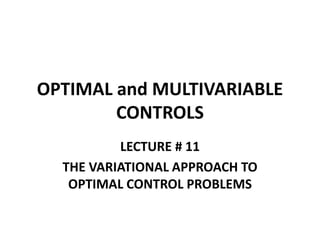lec11_OPTIMAL and MULTIVARIABLE CONTROLS.pptx
•Download as PPTX, PDF•
0 likes•64 views
optimal and multivariable control
Report
Share
Report
Share

Recommended
Recommended
More Related Content
Similar to lec11_OPTIMAL and MULTIVARIABLE CONTROLS.pptx
Similar to lec11_OPTIMAL and MULTIVARIABLE CONTROLS.pptx (20)
Numerical method for pricing american options under regime 

Numerical method for pricing american options under regime
Conversion of transfer function to canonical state variable models

Conversion of transfer function to canonical state variable models
Recently uploaded
Differences between analog and digital communicationanalog-vs-digital-communication (concept of analog and digital).pptx

analog-vs-digital-communication (concept of analog and digital).pptxKarpagam Institute of Teechnology
Recently uploaded (20)
Involute of a circle,Square, pentagon,HexagonInvolute_Engineering Drawing.pdf

Involute of a circle,Square, pentagon,HexagonInvolute_Engineering Drawing.pdf
The battle for RAG, explore the pros and cons of using KnowledgeGraphs and Ve...

The battle for RAG, explore the pros and cons of using KnowledgeGraphs and Ve...
Seismic Hazard Assessment Software in Python by Prof. Dr. Costas Sachpazis

Seismic Hazard Assessment Software in Python by Prof. Dr. Costas Sachpazis
Lesson no16 application of Induction Generator in Wind.ppsx

Lesson no16 application of Induction Generator in Wind.ppsx
Introduction to Arduino Programming: Features of Arduino

Introduction to Arduino Programming: Features of Arduino
Filters for Electromagnetic Compatibility Applications

Filters for Electromagnetic Compatibility Applications
Electrical shop management system project report.pdf

Electrical shop management system project report.pdf
analog-vs-digital-communication (concept of analog and digital).pptx

analog-vs-digital-communication (concept of analog and digital).pptx
Instruct Nirmaana 24-Smart and Lean Construction Through Technology.pdf

Instruct Nirmaana 24-Smart and Lean Construction Through Technology.pdf
Software Engineering - Modelling Concepts + Class Modelling + Building the An...

Software Engineering - Modelling Concepts + Class Modelling + Building the An...
Research Methodolgy & Intellectual Property Rights Series 1

Research Methodolgy & Intellectual Property Rights Series 1
lec11_OPTIMAL and MULTIVARIABLE CONTROLS.pptx
- 1. OPTIMAL and MULTIVARIABLE CONTROLS LECTURE # 11 THE VARIATIONAL APPROACH TO OPTIMAL CONTROL PROBLEMS
- 2. Necessary Conditions for Optimal Control • Problem • Assumptions – Admissible states and controls are not bounded. – Initial state x(t0)=x0 and initial time t0 are specified. – x is an nx1 vector and u is mx1 vector.
- 3. Necessary Conditions for Optimal Control • Previously, the following problem was considered • In control problems the trajectory is determined by the control u – We wish to consider functionals of n + m functions – Only m are independent known as controls – Function must satisfy ‘n’ different. equation constraints given in 5.1-1 • The difference between cost function given in 5.1-2 and previously considered functional is of is term involving final state and time i.e., • Assuming h is differential, it can be rewritten as
- 4. • The performance measure can now be expressed as
- 5. • Define • To determine variation of Ja, the variations are introduced.
- 7. Necessary Conditions for Optimal Control • Consider the terms involving h
- 8. Necessary Conditions for Optimal Control • In the integral term we have
- 11. Boundary Conditions • To determine boundary conditions 5.1-18 needs to be modified accordingly. • In all cases it is assumed that we have the n equations • The following boundary problems are discussed – Problems with fixed final time. – Problems with free final time.
- 12. Problems with Fixed Final Time • Different scenarios might occur such as • CASE 1 FINAL STATE SPECIFIED
- 14. Example 5.1-1
- 18. Problems with Fixed Final Time • CASE 2 FINAL STATE FREE
- 22. Problems with Fixed Final Time • CASE 3 FINAL STATE LYING ON A SURFACE DEFINED BY m(x(t))=0 • Example – Suppose that the final state of a second order system is required to lie on a circle – The admissible changes in x(tf) are tangent to the circle at point
- 23. CASE 3 FINAL STATE LYING ON A SURFACE DEFINED BY m(x(t))=0 • The tangent line is normal to the gradient vector
- 24. CASE 3 FINAL STATE LYING ON A SURFACE DEFINED BY m(x(t))=0 5.1-18
- 25. CASE 3 FINAL STATE LYING ON A SURFACE DEFINED BY m(x(t))=0 • Generalized Case • Each component of m represents a hyper-surface in the n-dimensional state space. • Thus, the final state lies on the intersection of the k hyper-surfaces. • is tangent/ normal to the each of the hyper-surface at the point
- 31. Problems with Free Final Time • If final time is free several situations might occur 1. Final state fixed 2. Final state free 3. x(tf) lying on a moving point 4. Final state lying on a surface defined by m(x(t))=0 5. Final state lying on a moving surface defined by m(x(t))=0
- 32. Case 1 Final State Fixed with Free Final Time
- 33. Case 2 Final State Free with Free Final Time
- 34. Case 3 x(tf) lying on a moving point with Free Final Time
- 35. Table 5-1
- 36. Case 4 Final state lying on a surface defined by m(x(t))=0
- 37. Case 4 Final state lying on a surface defined by m(x(t))=0
- 38. Case 4 Final state lying on a surface defined by m(x(t))=0
- 39. Case 4 Final state lying on a surface defined by m(x(t))=0
- 40. Generalized Case • Each component of m describes a hyper surface in the n- dimensional state space. • The final state lies at the intersection of the hyper surfaces defined by m. • ᵟxf is (to first order) tangent to each of the hyper surfaces at the point x*(tf,tf)
- 41. Generalized Case • Thus, ᵟxf is normal to each of the gradient vectors which are assumed to be linearly independent • The (2n+k+1) equations are